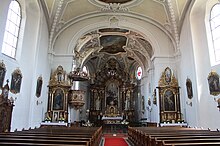St. Georg (Obertraubling)
The Catholic parish church of St. Georg in Obertraubling in the district of Regensburg ( Bavaria ) was built on July 5, 1908 in place of a previous building in the village center at Sankt-Georg-Straße 1.
Building history
There was probably already a Romanesque and later a Gothic predecessor church. In 1759 the foundation stone for a baroque church was laid. After it became increasingly dilapidated and too small despite repairs at the end of the 19th century, demolition began on April 4, 1907. After only one year, the new church , built according to plans by Johann Baptist Schott from Munich, could already be assigned on July 5, 1908. Some of the furnishings were taken over from the old church. On June 6, 2006, the tower got a newly created tower spire and a renewed onion.
Church building and equipment
The neo-baroque hall building with a retracted choir and tail gable also has classical and art nouveau elements . The tower with a mighty helmet and onion is 56 meters high. The high altar with angels and putti from 1913, made by the Jakob Helmer company from Regensburg , like the church itself, was only consecrated on May 25, 1919 by Bishop Antonius de Henle. The original high altar picture of St. Georgs in den Himmel has been missing since the end of the war and was painted by the painter Josef Wittmann painter of the neo-baroque in 1915. This high altar picture was sold after the Second World War with another two pictures in order to buy new church bells. All efforts to get this high altar painting by Josef Wittmann back were in vain. Today's altarpiece by Erwin Schöppl from 1946 shows St. George with the dragon. The frescoes in the choir: Martyrdom and Glory of George, divine virtues, dove with olive branch, pelican, hearts of Mary and Jesus, lamb, fish and bread basket are also by the church painter Josef Wittmann as well as the ceiling fresco in the nave, running through four scenes of George in one picture, also the cardinal virtues, the dragon fight, putti around the holy spirit hole and four emblems of the Lauret. Litanai. In 1919, after the Second World War, the painter Josef Wittmann created the pulpit paintings, two confessional paintings Ecco Homo and Magdalena and the Way of the Cross. In the chancel there are wooden, marbled and partly gilded figures of the Regensburg bishops Wolfgang and Albertus Magnus (made by the Jakob Helmer company from Regensburg) on both sides of the altarpiece . To the right of the high altar is a wooden Vespers picture with a representation of Mary with the dead son from 1480, which comes from the previous Gothic building. The three bells from the previous building were sold to Gailsbach in 1908 . The largest bell from 1859 is still preserved in Gailsbach. The warrior chapel of Our Lady of Sorrows is an octagonal building built in 1921 by Heinrich Hauberrisser with a canopy on pillars. The cemetery wall with segmented arched gates and plaster structures dates from 1910.
Also noteworthy are:
- Stone cross, so-called plague cross, Latin form with widened base, ins. 1520;
- Cemetery cross, cast iron cross with body on a stepped, partially renewed granite base, 1909 by J. Brandl
organ
The three-manual organ , consecrated in November 2009 - a new building by the organ building workshop Thomas Jann from Allkofen near Laberweinting - is one of the most powerful organ works from recent times in the Regensburg district. In a baroque organ case from the 18th century, it contains new voices and well-preserved registers of the previous instrument, which was built by Binder & Siemann in 1915 . The new organ with mechanical performance and electrical stop action comprises a total of 33 stops on three manuals and pedal . The disposition is as follows:
|
|
|
|
|||||||||||||||||||||||||||||||||||||||||||||||||||||||||||||||||||||||||||||||||||||||||||||||||||||||||||||||||||
- Mechanical coupling : I / P; III / P; Super III / P; II / I; III / I
- Electrical coupling: II / P; Super II / P; II / I; Sub II / I; Super II / I
- Playing aids : three steps ( crescendo , swell, solo work); Zimbelstern ; Setter with 5,000 combinations
Notes (Note)
- ↑ a b c d e f g h i j taken from Binder & Siemann (1915) and revised
- ↑ Register comes from the Johannes Schädler company from Donaustauf
Bells
The first bell of the current church building came from 1908 and was partially melted down for the armaments industry during the Second World War. The current five-part bronze ring (c 1 -d 1 -e 1 -g 1 -a 1 ) comes from the bell foundry Petit & Gebr. Edelbrock from Gescher in Westphalia and was made in 1947. It is tuned to the so-called "filled Salve Regina motif " and together represents the lowest pitched ringing of the Regensburg district.
Web links
Individual evidence
- ^ Georg Dehio: Handbook of German Art Monuments. Regensburg and Oberpfalz Deutscher Kunstverlag, Munich 1991, ISBN 3-422-03011-5 , p. 367 f.
- ^ Obertraubling, St. Georg . Online at jannorgelbau.com. Retrieved January 12, 2017.
- ↑ New organ in the diocese of Regensburg - The Jann organ in St. Georg, Obertraubling . Online at kirchenmusik-regensburg.de. Retrieved January 12, 2017.
Coordinates: 48 ° 57 '58.3 " N , 12 ° 10' 0.3" E



